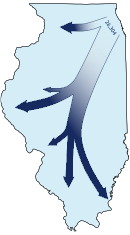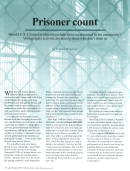Illinois has enacted legislation to end prison gerrymandering. While more than a dozen states counted incarcerated people at home for redistricting purposes in the 2020 redistricting cycle, Illinois' law will not go into effect until the 2030 cycle.
Illinois
- Sections
- Legislation
- Testimony
- Organizations in Illinois
- Endorsements
- Fact sheets
- Additional reading
After the 2000 Census, Illinois counted 26,304 mostly Black and Latino residents of Chicago as residents of downstate prison towns, which had a staggering impact on democracy at both the state, and county levels. Most of the state’s prisoners (60%) are Chicago residents, but the vast majority of them (90%) are counted as residents of downstate prisons. This miscount of incarcerated people misrepresents Illinois’ demographic makeup and skews its system of legislative representation. The Census Bureau continues to count Illinois' incarcerated residents at the prison locations rather than at home, but a growing campaign seeks to eliminate prison gerrymandering by changing how the state and counties use the Census data.
Every prison built in Illinois after 1941 was built more than 100 miles away from Chicago; the average distance from Chicago to a prison is more than 200 miles. The State bars people in prison from voting, but their presence in the Census boosts the population of the downstate districts whose legislators favor prison expansion. After the 2001 redistricting 11 downstate House districts were padded with substantial prison populations, skewing district boundaries throughout the state.
The problem is even more serious in county government, where large prisons can dominate the comparatively small populations of county legislative and supervisory districts. After redistricting following the 2010 Census, for example, 34% of LaSalle County's 6th district is incarcerated, giving every group of 66 residents in that district the same voting power as 100 residents in any other district.
Counties and municipalities, however, need not wait for state action to solve prison-based gerrymandering problems. The City of Crest Hill, for example, adjusts population data when drawing its districts, and excludes the prison population. Crest Hill's District 2 contains Stateville Correctional Center, it would be about 60% prisoners if the City included the prison in population data when redistricting in 2012.
Legislation
Current session:
- HB 0203, “No Representation Without Population Act,” sponsored by Representatives LaShawn K. Ford, prefiled on December 19, 2018. The bill language was inserted as an amendment into HB 3653, which passed both houses January 13, 2021, and is currently awaiting Governor's signature.
Previous legislation:
- HB 0205, "No Representation Without Population Act," sponsored by Representatives LaShawn K. Ford, prefiled on December 5, 2016.
- HB 1489, "No Representation Without Population Act," cosponsored by Representatives LaShawn K. Ford, Mary E. Flowers, Eddie Lee Jackson, Sr., Camille Y. Lilly, Jehan A. Gordon-Booth, Emanuel Chris Welch, Carol Ammons, Kenneth Dunkin and Arthur Turner, filed on February 5, 2015.
- HB 62 No Representation Without Population Act, prefiled by Rep. LaShawn K. Ford, January 3, 2013
- Prisoner Census Adjustment Act, HB94 Prisoner Census Adjustment Act, introduced by Rep. LaShawn K. Ford, January 12, 2011. Amended and passed out of committee, but failed to pass a floor vote.
- Fact sheet about HB94 [PDF]
Testimony
- Josina Morita, Director of the United Congress of Community and Religious Organizations, 3/20/13
Organizations in Illinois
It’s impossible to include everyone who is working toward fair districting in Illinois, but if you are looking to get involved, these are some of the people and organizations you might want to contact:
- Ryan Tolley, CHANGE Illinois
- Josina Morita, United Congress of Community and Religious Organizations
- Dan Johnson-Weinberger at Progressive Public Affairs
Endorsements
- The New York Times editorial board has supported this movement in over 10 editorials, including Phantom Voters in New York, Prison-Based Gerrymandering, and Phantom Voters, Thanks to the Census.
Fact sheets
- Support HB 62 [PDF] No Representation without Population Act: Ensuring fair representation for all Illinoisans (United Congress of Community and Religious Organizations)
- Prison-Based Gerrymandering in Illinois [PDF]
- Majority of Illinois counties & cities with large prisons reject prison-based gerrymandering [PDF]
- Fact sheet about the bill [PDF]
- Prison-based Gerrymandering in Clinton County, Illinois [PDF]
- Prison-based Gerrymandering in Kankakee County, Illinois [PDF]
- Prison-based Gerrymandering in LaSalle County, Illinois [PDF]
- Prison-based Gerrymandering in Pittsfield, Illinois [PDF]
- Prison-based Gerrymandering in Vermilion County, Illinois [PDF]
Additional reading
- Prison-based gerrymandering is a problem for all Illinoisans, especially for those in counties near prisons, by Josina Morita, Executive Coordinator, The United Congress of Community and Religious Organizations, March, 2011
 Importing Constituents: Prisoners and Political Clout in Illinois (2010) is our district-by-district analysis of how crediting Chicago’s incarcerated residents to downstate districts distorts democracy and flouts federal and state law. Analysis is based on redistricting after the 2000 Census.
Importing Constituents: Prisoners and Political Clout in Illinois (2010) is our district-by-district analysis of how crediting Chicago’s incarcerated residents to downstate districts distorts democracy and flouts federal and state law. Analysis is based on redistricting after the 2000 Census.
 Prisoner Count: Should U.S. Census tabulatons include those incarcerated in the prison's community? Voting rights activists are among those who don't think so, [PDF] by Jessica Pupovac, Illinois Issues, February, 2010
Prisoner Count: Should U.S. Census tabulatons include those incarcerated in the prison's community? Voting rights activists are among those who don't think so, [PDF] by Jessica Pupovac, Illinois Issues, February, 2010





